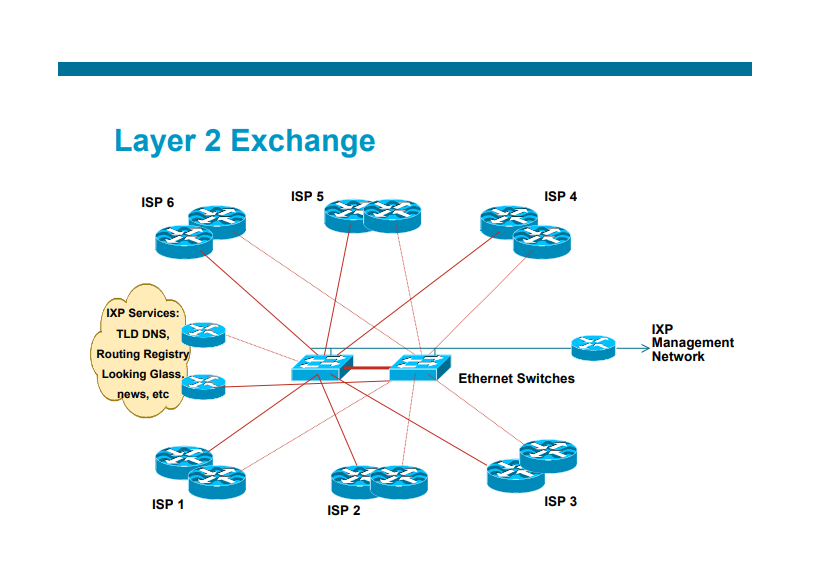Internet Exchange Points (IXP)
What is an IXP?
Before IXP existed in Indonesia, the e-mail had to be streamed to overseas networks, then forwarded to the recipient. This of course requires too high a fee because the connection to the international internet network is subject to fees.
With IXP, this doesn't have to be the case. Internet Exchange Point is a physical infrastructure where internet service providers and Content Delivery Networks connect and exchange traffic between their respective networks. IXP allows all devices in the network to be connected locally in Indonesia, without having to be diverted abroad first. This enhancement of course cuts costs, bandwidth and increases access speed in the network.
Benefits of Internet Exchange Point
To better understand the functions of the IXP, we summarize some of the benefits of Internet Exchange Points:
-
More efficient local traffic
As implied in the earlier analogy, the exchange of traffic with fellow local providers who are members of the IXP makes the exchange of internet access more efficient. As a result, the performance of applications and websites is better. This makes the use of the IXP very profitable for small and local businesses, universities, and similar institutions. -
Easier international internet access
If the IXP in a country is connected to another internet exchange network abroad, users can access content without having to go through a busy and busy international traffic lane. In other words, IXP shortens the network distance so that internet service providers can more easily exchange internet traffic and shorten data access points. This allows users watching YouTube from Indonesia, for example, to access content on YouTube servers in the United States more quickly and smoothly. -
Increase redundancy
Internet service providers / providers rely heavily on IP Transit. When one of them has a problem, the internet provider will lose control of the routing. The traffic exchange within the IXP provides an alternative route that is backed up in the event of a transit failure. This redundancy can improve internet connection performance that is felt by users.
Why are Internet Exchange Point important?
Without IXPs, traffic going from one network to another would potentially rely on an intermediary network to carry the traffic from source to destination. These are called transit providers. In some situations there’s no problem with doing this: it’s how a large portion of international Internet traffic flows, as it’s cost prohibitive to maintain direct connections to each-and-every ISP in the world. However, relying on a backbone ISP to carry local traffic can be adverse to performance, sometimes due to the backbone carrier sending data to another network in a completely different city. This situation can lead to what’s known as tromboning, where in the worst case, traffic from one city destined to another ISP in the same city can travel vast distances to be exchanged and then return again. A CDN with IXP presence has the advantage of optimizing the path through which data flows within it’s network, cutting down on inefficient paths.
Now, let's talk about the main advantages of the Internet Exchange Points. Using Internet Exchange Points has many advantages, but the most important ones are: cost reduction, latency and bandwidth improvements and an increase in routing efficiency and fault tolerance.
-
Cost Reduction
Thanks to this type of infrastructure, the traffic share an ISP must deliver to its connectivity provider diminishes; and so do the costs. The traffic that travels through this infrastructure isn’t usually billed by any of the parties; as opposed to what would happen with the network of a connectivity provider. -
Latency and bandwith improvements
This direct interconnection also prevents data from having to travel from one city to another (or even outside the country or the continent) in order to go from one network to another. Thus, reducing latency. However, that’s not all. Speed increases significantly, especially in areas where long-distance connections aren’t very developed. Generally, an Internet Exchange Point considerably improves bandwidth between the clients of two neighbor ISPs within the point.
How Does an IXP Work?
The basic concept of IXP is not that different from a home network, just on a much larger scale. It is a Layer 2 LANs with Ethernet switches at its core connecting a whole bunch of its members' routers. With this, ISPs can peer with each other through a single public hub.

The Layer 2 IXP diagram above illustrate how an IXP connects ISPs to each other and also offer services that should benefits all of its members. Each router needs an Ethernet port to connect to the switch, a WAN port leading back to the ISP backbone, and to be able to run BGP to be able to peer with other members.
References
- Internet Exchange Points, an essential role on the Internet. Stackscale. Retrieved August 6, 2020 from https://www.stackscale.com/blog/internet-exchange-points/
- What is an Internet exchange point? | How do IXPs work?. cloudfare. Retrieved 2021 from https://www.cloudflare.com/learning/cdn/glossary/internet-exchange-point-ixp/
- Apa Itu IXP atau Internet Exchange Point?. My Matrix. Retrieved May 31, 2020 from http://www.mymatrix.net.id/id/news/75/ixp#:~:text=Internet%20Exchange%20Point%20merupakan%20infrastruktur,traffic%20antar%20jaringan%20masing-masing.&text=Penyingkatan%20ini%20tentunya%20memangkas%20biaya,meningkatkan%20kecepatan%20akses%20dalam%20jaringan
- The Pacific Network Operators Group. (2009). IXP Design. https://www.pacnog.org/pacnog6/IXP/IXP-design.pdf
- Telehouse. (2018, October 5). How Does Internet Exchange Point Work. https://www.telehouse.com/how-does-internet-exchange-work/